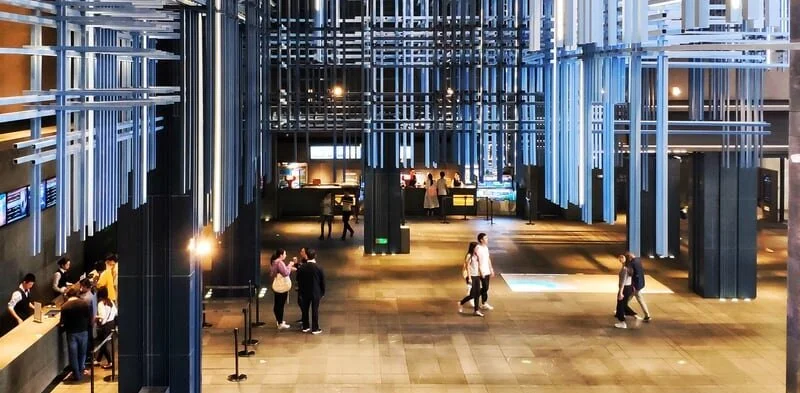The team and timeline
As a team, working on a separate research studies, we had daily scrums and updates, making sure everyone is informed at all times.
Context
Azure Computer Vision Service is an AI service which can process images and link it to information stored. It can be used to tag visual features, recognize faces or image types, detect objects and more. Spatial Analysis, part of Computer Vision, can detect people in the video and track people. For example, it can be used to track shoppers in the store or track employees and visitors in office buildings to see how people use the space. As such, this technology has a potential to impact building occupants. Understanding this impact would lead to responsible AI use recommendations, something that Microsoft is very passionate about.
The overall goal of this research was to aid in assessing possible solutions and harms of facial recognition use in office buildings (see more about harms modeling here). Specifically, to consider stakeholders that may be affected and identify ways to mitigate perceived challenges.
Source: https://docs.microsoft.com/en-us/azure/architecture/guide/responsible-innovation/harms-modeling/
Research plan and questions
Determine what information needs to be disclosed to stakeholders
Determine how to disclose information, purpose and method of data collection and data use
How to build trust with affected stakeholders (e.g., building occupants, reception and security staff)
Research was split into three research studies running concurrently
Interviews with individuals from ethnic minority groups and people with disabilities
Interviews with reception and security staff
Cognitive walkthroughs exploring onboarding, data collection and disclosure
My part of this project - Interviews with reception and security staff
Reception staff often manage visitors and employees in the building and oversee building access. One of the questions we wanted to explore was how does reception staff perceive working with this technology and what impact this may have on their current duties, if this technology is also used to manage building access.
Method - In depth interviews and concept testing
My role was to explore, through in-depth interviews with receptionists and security guards, how this new technology would impact their tasks and responsibilities at work and what challenges it may pose.
We also wanted to know what would be an ideal way of onboarding to using and maintaining this technology.
In order to do this, I had to establish what tasks and responsibilities they currently have at work and what knowledge they have about facial recognition. I then introduced a concept of facial recognition in the office building and asked them to imagine their typical day with this technology in place.
Finally, I explored expectations around onboarding and working with this system in place.
Outcome
Identified ways of building trust
Identified best practices for adopting this technology
Identified potential harms and frustrations the system may cause and ideas for how to minimize them
Created recommendations for responsible use for Vision services
All three studies contributes to several recommendations for Computer Vision documentation.
Recommendations that resulted from the research studies led by me are circled in yellow.
Source: https://docs.microsoft.com/en-us/legal/cognitive-services/computer-vision/disclosure-design
Key insights
In this section, I will only cover key insights from my part of the research: Interviews with receptionists and security guards.
Better security and easier access after the initial set up
Overall the reaction to the idea of facial recognition in the office building was positive. Some additional duties during onboarding were expected.
Reception duties also vary. Those with more complex workloads were more open to facial recognition, because they assumed it would mean fewer interruptions (e.g., managing access).
Expected to learn about the system and receive training
Reception staff did not want to feel powerless in case of the system failures or with regards to the system, they wanted to be able to help the affected stakeholders (visitors, building staff). They expected to learn about the technology and its performance and shortcomings and be updated regularly. They also wanted to be able to communicate their concerns.
Possible impact to duties and responsibilities
Participants thought that, with introduction of this technology, their duties and responsibilities might change in the future.
Source: https://docs.microsoft.com/en-us/azure/architecture/guide/responsible-innovation/harms-modeling/
Opinions of affected stakeholders matter. They are important for assessing harm technology may pose when used.
Next steps
From perceived impact to measuring actual impact
With the new system in place, it is important to make sure to continually evaluate performance and impact on stakeholders, as well as identify challenges and areas of improvement. This can be done in two ways
Observations/Contextual inquiry to observe how reception and security staff work in conjunction with this technology
Interviews to explore thoughts, feelings, frustrations and ideas for improvement
Reflections
Reflecting on the study, there are several things that were successful
Methodology allowed us to discover rich insights
Daily scrums and updates were helpful in keeping everyone aligned and generating collective feedback on the project
However, I also hit some roadblocks
For example, recruitment of participants was difficult due to narrow criteria. To work around this I:
Improved the screener
Offered flexible interview slots
Recruited through other avenues
Now, when I anticipate recruitment to be difficult due to very narrow criteria, I allow extra time for recruitment, use more rigorous pre screening method and always have a plan B (how to recruit if my plan A fails)








